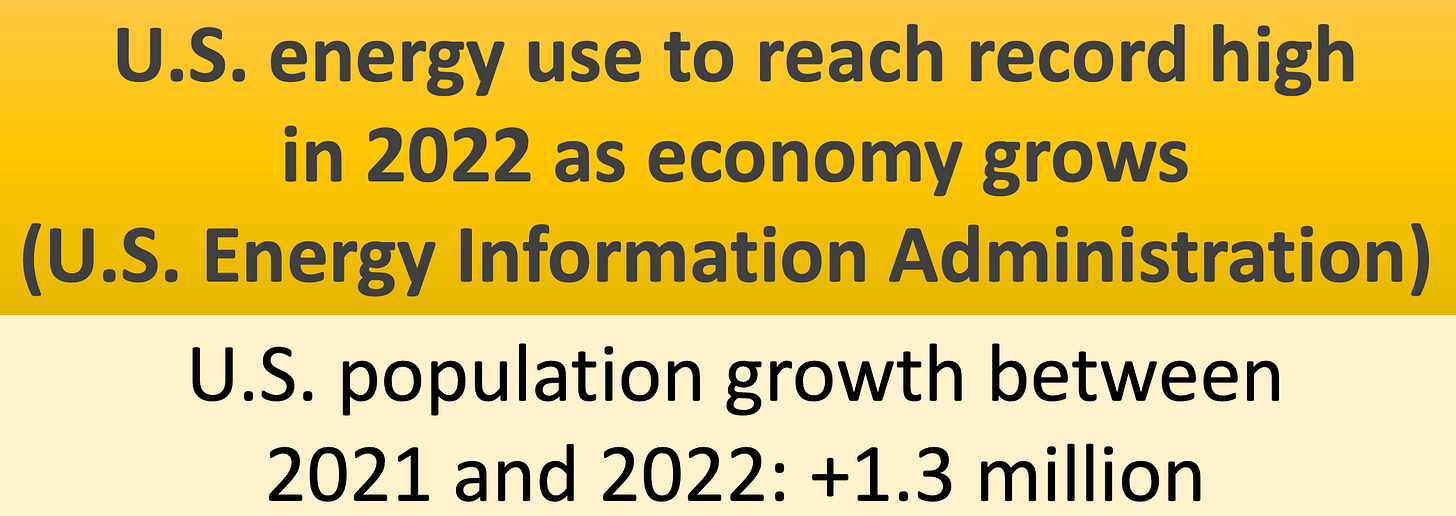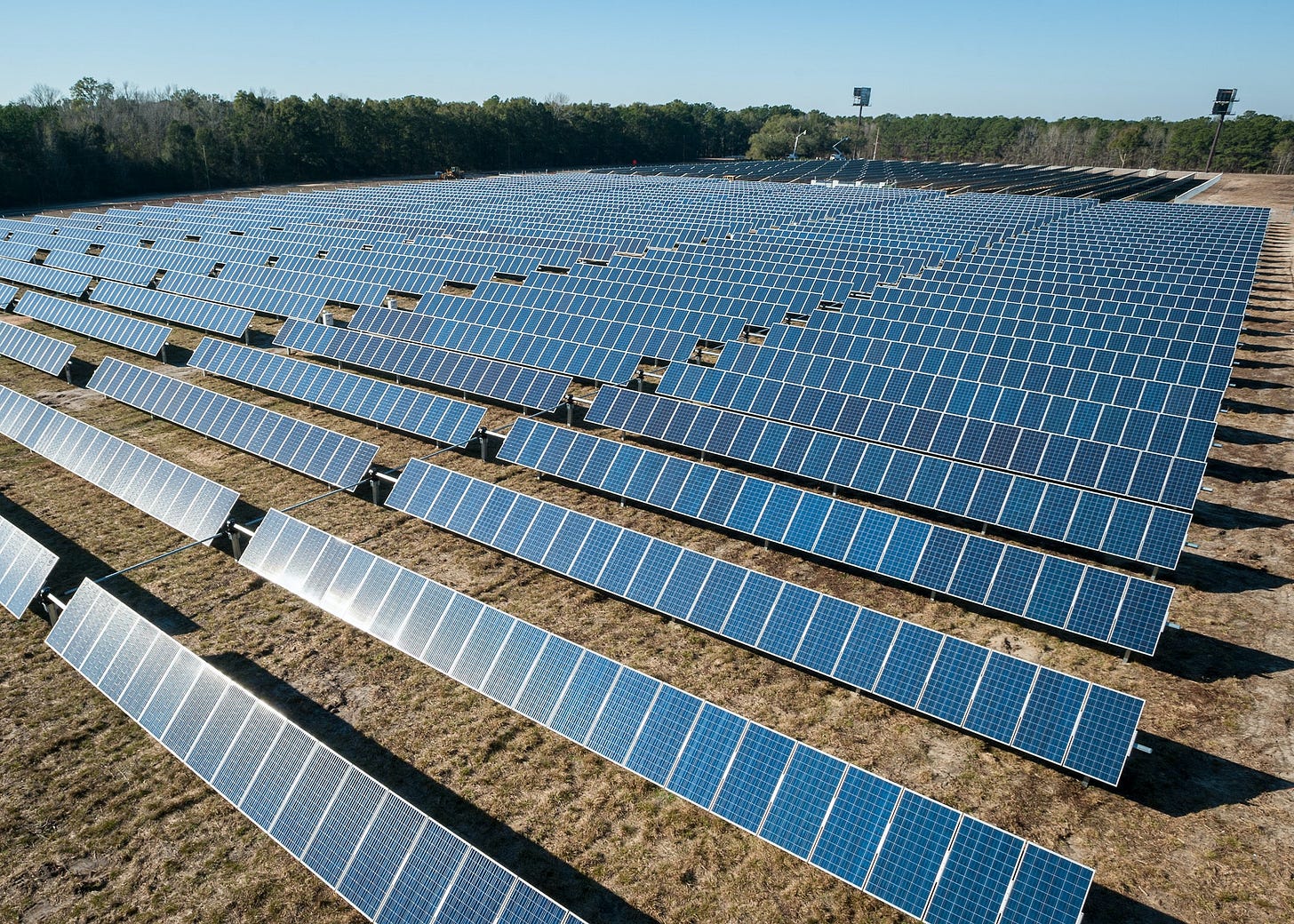How much does U.S. population growth cut gains made by solar energy to reduce carbon emissions?
Here's my stab at answering that question.
In Memory of Herman Daly, pioneer steady-state economist, 1938-2022
THERE’S A NASTY FIGHT underway over plans to convert a large area of Indiana farmland for solar energy generation. A recent article in The Guardian describes the project, its ugly politics and its environmental and economic pros and cons.
The chief selling point is that the "Mammoth Solar Farm" would, while replacing an agricultural area the size of Manhattan (NY), supply 1.3 gigawatts of energy to meet the needs of more than 200,000 households.
Each year, the U.S. requires about 500,000 extra households to keep up with population growth (see footnote). That means about 2.5 solar developments the size of Mammoth are needed annually to keep pace with household energy use from population growth (about 3.25 gigawatts.)
The U.S. Energy Information Administration expects utility-scale solar generating capacity to grow by 21.5 gigawatts in 2022. So, population growth would take about 15% of that for household use.
But there's also non-household energy demand tied to a yearly addition of 1.3 million people to the U.S. population. Residential energy use on average is only about a fifth of the total energy needed to support someone. The rest is connected to industry, transportation and commerce.
So, population growth may use 75% of new solar capacity that comes online in 2022. Considering that there's a shortfall of about 5 million housing units in the U.S., the population effect becomes even more significant. Home construction has apparently not kept pace with population growth over the past 20 years.
The Guardian article points out that, "If the US really is to zero out its carbon emissions by 2050, researchers at Princeton University have estimated that solar production could have to grow more than 20-fold, occupying an area that, put together, would be equivalent to the size of West Virginia."
Obviously, that vast amount of land for the solar industry has to come from somewhere, most likely from farmland or wildlife habitats such as forests, grasslands, and desert. So expect more conflict over land use, along with potential global supply chain, economic, and political issues, that could prevent solar energy expansion anywhere close to that 20-fold extent. (China is by far the largest producer of solar panels; its relations with the U.S. are in decline to the point of halting bilateral talks on climate change.)
An alternative to large land-altering projects like Mammoth would be to place most solar infrastructure on rooftops and along highways. I like that approach. But it’s unclear if it can surmount technical, economic, and political constraints to become the main player in solar energy generation for the U.S.
Getting a massive renewable energy network up and running in time to avert the worse of climate change is problematic given growing human numbers, rising energy demand, pushback from local communities and many environmentalists, and uncertain political and economic stability.
The U.S. should cut energy consumption to help meet climate policy goals while softening environmental impacts from so-called “green” industrialization. That could be done by reducing overall energy consumption (including that by the military) and by stabilizing population. The fertility rate in the U.S. may have flattened but immigration is likely to increase, especially if economic, political, and environmental conditions worsen around the world. An honest national discussion is needed on how population growth affects carbon emissions and more broadly the environment.

The overgrowth problem of the U.S. is, of course, not only about energy consumption and climate change. The bigger we get, the more buildings, roads, traffic, commercial centers, and just about everything we'll need. All of that takes additional resources — to be extracted from nature at home and abroad (sometimes at the expense of other people as well as at great cost to nonhuman life). Our society, for the time being, seems perfectly fine with more resource exploitation. Frankly, that’s insane. The tragedy of overconsumption will continue until we as a society come to terms with limits to growth.
***
If our ethical understanding of the value of “sustainability” (longevity with sufficiency) is to “maximize” cumulative lives ever to be lived, subject to a per capita consumption level sufficient for a good life, then we must limit the load we place on Earth at any one time. Fewer people, and lower per capita resource consumption, facilitated by more equitable distribution, mean more (and more abundant) lives for a longer, but not infinite, future. There is no point in maximizing the cumulative number of lives lived in misery, so the qualification “sufficient for a good life” is important, and requires deep rethinking of economics and a shift of focus from growth to sufficiency, including sufficient habitat for other species. It also requires a rethinking of the traditional pro-natalist dogmas of the fundamentalist branches of most religions, including Christianity, Islam, and Judaism. The modern secularist religions of Marxism and Scientism likewise proselytize for the Ecumenical Church of Growthism while ignoring population. — Herman Daly
_____
Footnote: The US population is growing by about 1.3 million people (based on 2021-2022 data). If that remains constant, about 500,000 extra households are needed annually (given an average of 2.6 persons per household).




For now I think we need to put solar panels on as many buildings as possible. We need our farmland and we also need land for wildlife. Most plants and animals can't live under solar panels.
Comment emailed to me from Gail Clark (she ok'd posting it here):
Well done, Tony. My concern is that the topic is vast and, by many standards, complicated.
The general public including “environmentalists” seem to refuse (or are unable) to consider the drawbacks of full speed head-on “green energy”. And it’s confusing. IMO it’s reckless. Too, trading off farmland for solar (or wind)…as the population increases? I understand they can’t be built in cities which is obvious. Which brings us to one of your suggestions - roadways, rooftops, ALL new development, etc. I feel we may be on a collision course if we don’t soon apply common sense to this race to “save the planet”. And, of course, scaling down would be the best single thing we could do right now, but considering the current political climate, no politician or government is going to touch that subject.
It’s gonna be quite a ride!
My reply:
Thanks, Gail, for your feedback!
Indeed, no political leader or government at this time would call for scaling down consumption of natural resources and population in order to fight climate change and, more broadly, to save the natural environmental from further devastation by overgrowth. Either they are blinded by the false promise of technological salvation and fanciful "sustainable development," or they actually understand limits to growth and fear to address the matter.
I say "at this time" because through an honest and well-circulated national conversation about the negative impacts of overgrowth, some brave and insightful leaders could potentially build public support for scaling down — as such would mean a better, higher quality, and more secure future for people and their children.
Ironically, right now there is government action being taken to, in fact, scale down. But it has nothing to do with the environment, and is considered a prerequisite for even more (unsustainable) economic growth. I'm referring to temporarily raising interest rates to fight inflation by cooling the economy. To the extent that the tactic fails, it may further erode public confidence in government's ability to solve problems.
Worse still, and directly related to the environmental issues we're discussing, would be failure of government investment and political promotion to shift to renewable energy without triggering a huge, enduring energy crisis resulting from a shortfall of fossil fuels. Unfortunately, such circumstances would make it all the more difficult, if not impossible, to inspire people to scale down for their well-being and for Earth's.
I wish I had the answer as to how we can turn society around. Maybe you, or I, or someone like us could enter politics and run a #LivingEarthPolicy campaign. It would be a wild ride!
Tony